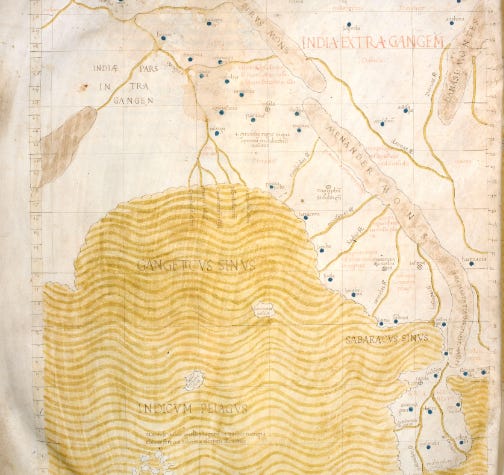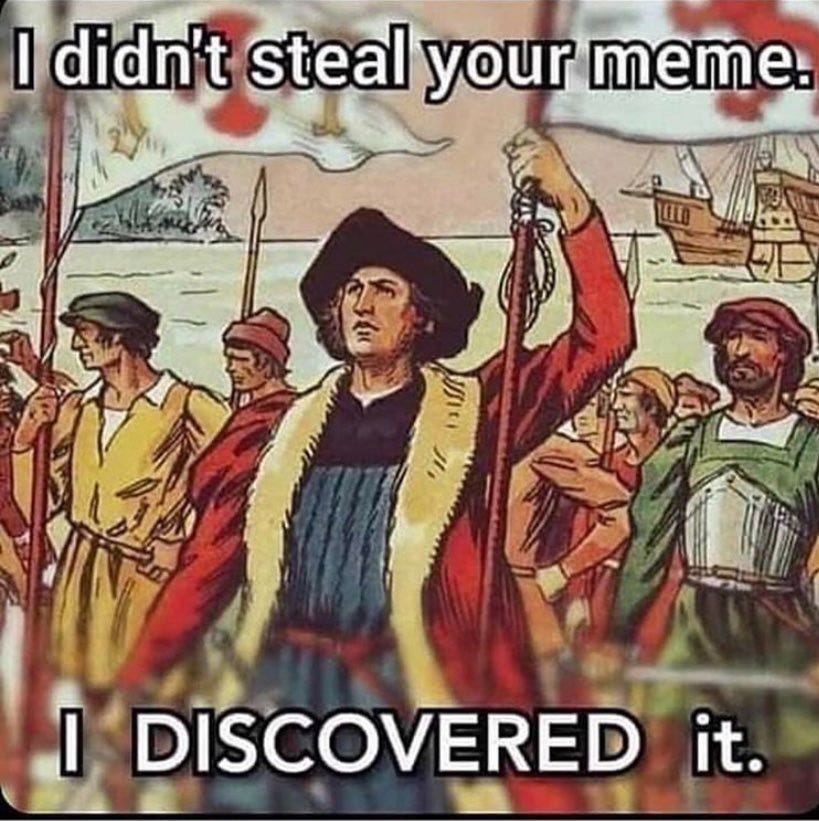Cristoffa Corombo was Bad Person with No Taste
Or, how educated, self-aware, and motivated foodies can change the world
Scientific Methodology
For all of pre-modern human history, with no gas lamps or electricity, after the sun went down, it got dark.
Classical civilizations had a lot of time on their hands staring up at the sky to observe the position of celestial bodies.
Glass lenses weren’t invented until the 13th century in Italy.
Lenses were mainly held to the top of the nose by monks for reading or writing texts…when they weren’t enduring sieges.
Despite limitations of technology, engineering, and math, ancient scientists like Pythagoras were able to calculate the approximate size of the Earth.
The idea of a spherical Earth was floated around by Pythagoras (500 BCE) and validated by Aristotle a couple centuries later.
They observed movement of the Sun, moon, and stars, making observations and collecting empirical data to eventually propose that the planet was a sphere.
Flat Earthers and other willfully ignorant people have been mad about it ever since, throwing their hands up in the air and saying, “Well, it’s Greek to me!”
They’re not even wrong.
Eratosthenes of Cyrene was the first person known to calculate the planet’s axial tilt.
Eratosthenes used an ingenious method to calculate the Earth's circumference by measuring the angle of the Sun's rays at two different locations on the same day.
He recognized that the difference in the angles was due to the curvature of the Earth and used this information to calculate the planet's size.
He never even left his hometown of Alexandria.
Without magnifying lenses or modern appliances Eratosthenes' calculation was fairly accurate.
Considering telescopes were still millennia away, his estimate of the Earth’s measurements had a margin of error in percentage points.
Not too bad for folks who had just gotten around to inventing geometry.
Foodies Valued Taste
Spices were expensive and a sign of status in the Roman Empire.
The wealthiest patricians consumed huge quantities.
The Spice Routes were famous for transporting the most common - and pricey - products, including anise, cardamom, chilies, cinnamon, clove, cumin, ginger, pepper/corn, nutmeg, saffron, and turmeric.
A combination of these spices is what wafts out of the office kitchen microwave when your co-worker reheats last night’s chicken tikka masala.
Early modern foodies valued that smell and would pay millions of denarius, pesetas, and dinheiros to get a taste.
Genoese product navigator-mercantilist Cristoffa Corombo was the man to bring the heat.
Complicated Spice Routes
The oldest surviving manuscript of Ptolemy's Greek text was copied more than 1,000 years after he wrote it; dating from the late 12th or early 13th century.'
Ptolemy's Geography was translated into Latin in the early 13th century, introduced into western Europe and used to create maps of the world, displaying India and the Bay of Bengal.
Marco Polo traveled to China between 1271 and 1295. In his book, he describes the people, places, and customs of the East.
Calcutta was under the rule of the Bengal Sultanate from the 14th to 16th centuries.
At the time, the Sultanate was a major trading partner in the world and was described by Europeans as the richest country to trade with.
Corombo had read Marco Polo's book with excitement, which drew his interest in attempting to reach the Far East.
Europeans needed to find a sea route because hostile Ottoman and Mughal Empires stood between them and Asia.
Using Marco Polo's writings amongst other sources, Columbus calculated that his voyage would lead him to Cathay (China), Cipango (Japan), and India.
He could practically taste the spices.
Gets Lost & Take All the Credit
Columbus was not a scientist like Eratosthenes.
Only idiots escape entirely from the world that the past bequeaths.
Columbus underestimated the distance to Asia by thousands of miles because he used obsolete Greek data to make his calculations.
He deceived his sailors about the actual large distance they had covered to avoid a mutiny. The miscalculation led to a lack of food and water, which resulted in some of the crew becoming sick and - eventually - dying.
Columbus sailed from Palos de la Frontera on Friday, August 3, 1492, reached the Canary Islands six days later and stayed there for a month to finish outfitting his ships.
He left on September 6, and five weeks later, in about the place he expected, he found the Indies.
What else could it be but the Indies?
There on the shore were the naked people.
With hawk's bells and beads, he made their acquaintance and found some of them wearing gold nose plugs.
It all added up.
Where else could he possibly be?
the amount of gold worn by the natives was even less than the amount of clothing
From a product management perspective, Columbus had made the business case, built features by tricking his team, and gone to market later refusing to believe, accept, and internalize the outcome of his navigational experiment.
Despite the Bengal Sultanate’s documented reputation for wealth and source for lucrative spices, Columbus leaned into his biases, ignorance, and motivated reasoning.
The distance traveled, the culture of the people nor their material possessions squared with a millennium of scientific evidence, known rulers, or even cooking ingredients.
And he wanted to be paid in gold for his effort.
Columbus ordered every Indian over 14 to give a large quantity of gold to the Spanish, on pain of death.
Cristoffa Corombo may have been a skilled product navigator, but he was a moron, a liar, and a generally bad person.
Takeaway
Having a vision is fundamental, fulfilling a lucrative business need is critical, and reconciling lived experience with known data sources is essential.
More importantly, being transparent with your team, aligning on incentives, and actually breaking bread with people you meet along the way will go a long way to setting your product management legacy.
“If I'm an advocate for anything, it's to move.
As far as you can, as much as you can.
Across the ocean, or simply across the river.
The extent to which you can walk in someone else's shoes or at least eat their food, it's a plus for everybody.
Open your mind, get up off the couch, move.”
— Anthony Bourdain






